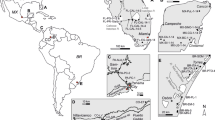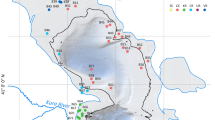Abstract
Many studies in continental areas have successfully used the oxygen isotope composition of fossil ostracod valves to reconstruct past hydrological conditions associated with large changes in climate. Yet, ostracods are known to crystallise their valves out of isotopic equilibrium for oxygen and they generally have higher 18O contents compared to inorganic calcite grown at equilibrium under the same conditions. A review of vital offsets determined for continental ostracods indicates that vital offsets might change from site to site, questioning a potential influence of environmental conditions on oxygen isotope fractionation in ostracods. Results from the literature suggest that pH has no influence on ostracod vital offset. A re-evaluation of results from Li and Liu (J Paleolimnol 43:111–120, 2010) suggests that salinity may influence oxygen isotope fractionation in ostracods, with lower vital offsets for higher salinities. Such a relationship was also observed for the vital offsets determined by Chivas et al. (The ostracoda—applications in quaternary research. American Geophysical Union, Washington, DC, 2002). Yet, when results of all studies are compiled, the correlation between vital offsets and salinity is low while the correlation between vital offsets and host water Mg/Ca is higher, suggesting that ionic composition of water and/or relative abundance of major ions may also control oxygen isotope fractionation in ostracods. Lack of data on host water ionic composition for the different studies precludes more detailed examination at this stage. Further studies such as natural or laboratory cultures done under strictly controlled conditions are needed to better understand the potential influence of varying environmental conditions on oxygen isotope compositions of ostracod valves.


Similar content being viewed by others
References
Chivas AR, De Deckker P, Wang SX, Cali JA (2002) Oxygen-isotope systematics in the nektic ostracod Australocypris robusta. In: Holmes JA, Chivas AR (eds) The Ostracoda—Applications in Quaternary Research. American Geophysical Union, Washington DC, Geophysical Monograph 131, pp 301–313
Davis JK, Dove PM, De Yoreo JJ (2000) The role of Mg2+ as an impurity in calcite growth. Science 290:1134–1137
Decrouy L, Vennemann TW, Ariztegui D (2011) Controls on ostracod valve geochemistry: part 2. carbon and oxygen isotope compositions. Geochim Cosmochim Acta 75:7380–7399
Dettman DL, Smith AJ, Rea DKR, Moore TC, Lohmann K (1995) Glacial meltwater in Lake Huron during early postglacial time as inferred from single-valve analysis of oxygen isotopes in ostracodes. Quat Res 43:297–310
Friedman I, O’Neil JR (1977) Compilation of stable isotope fractionation factors of geochemical interest. In: Friedman I, O’Neil JR (eds) Data of Geochemistry. US Geological Survey, Washington DC, pp KK1–KK12
Fritz P, Anderson TW, Lewis CFM (1975) Late-quaternary climatic trends and history of Lake Erie from stable isotope studies. Science 190:267–269
Heaton THE, Holmes JA, Bridgwater ND (1995) Carbon and oxygen isotope variations among lacustrine ostracods: implications for palaeoclimatic studies. Holocene 5:428–434
Ito E, Forester RM (2009) Changes in continental ostracod shell chemistry; uncertainty of cause. Hydrobiologia 620:1–15
Keatings KW, Heaton THE, Holmes JA (2002) Carbon and oxygen isotope fractionation in non-marine ostracods: results from a ‘natural culture’ environment. Geochim Cosmochim Acta 66:1701–1711
Kim S-T, O’Neil JR (1997) Equilibrium and nonequilibrium oxygen isotope effects in synthetic carbonates. Geochim Cosmochim Acta 61:3461–3475
Kim S-T, O’Neil JR, Hillaire-Marcel C, Mucci A (2007) Oxygen isotope fractionation between synthetic aragonite and water: influence of temperature and Mg2+ concentration. Geochim Cosmochim Acta 71:4704–4715
Li X, Liu W (2010) Oxygen isotope fractionation in the ostracod Eucypris mareotica: results from a culture experiment and implications for paleoclimate reconstruction. J Paleolimnol 43:111–120
Li H-C, Stott LD, Hammond EH (1997) Temperature and salinity effects on 18O fractionation for rapidly precipitated carbonates: laboratory experiments with alkaline lake water. Episodes 20:193–198
Marco-Barba J, Ito E, Carbonell E, Mesquita-Joanes F (2012) Empirical calibration of shell chemistry of Cyprideis torosa (Jones, 1850) (Crustacea: Ostracoda). Geochim Cosmochim Acta 93:143–163
Mavromatis V, Schmidt M, Botz R, Comas-Bru L, Oelkers EH (2012) Experimental quantification of the effect of Mg on calcite aqueous oxygen isotope fractionation. Chem Geol 310–311:97–105
von Grafenstein U, Erlenkeuser H, Trimborn P (1999) Oxygen and carbon isotopes in modern fresh-water ostracod valves: assessing vital offsets and autecological effects of interest for palaeoclimate studies. Palaeogeogr Paleoclimatol Palaeoecol 148:133–152
Wetterich S, Schirrmeister L, Meyer H, Viehberg FA, Mackensen A (2008) Artic freshwater ostracods form modern periglacial environments in the Lena River delta (Siberian Artic, Russia): geochemical applications for palaeoenvironmental reconstructions. J Paleolimnol 39:427–449
Xia J, Ito E, Engstrom DR (1997) Geochemistry of ostracod calcite: part 1. An experimental determination of oxygen isotope fractionation. Geochim Cosmochim Acta 60:377–382
Xu H, Hou Z, An Z, Liu X, Dong J (2010) Major ion chemistry in Lake Qinghai catchments, NE Qinghai-Tibet plateau, China. Quat Int 212:35–43
Acknowledgments
The authors would like to thank Javier Marco-Barba and Emi Ito for thorough and useful reviews of our manuscript.
Author information
Authors and Affiliations
Corresponding author
Rights and permissions
About this article
Cite this article
Decrouy, L., Vennemann, T.W. Potential influence of the chemical composition of water on the stable oxygen isotope composition of continental ostracods. J Paleolimnol 50, 577–582 (2013). https://doi.org/10.1007/s10933-013-9719-5
Received:
Accepted:
Published:
Issue Date:
DOI: https://doi.org/10.1007/s10933-013-9719-5




